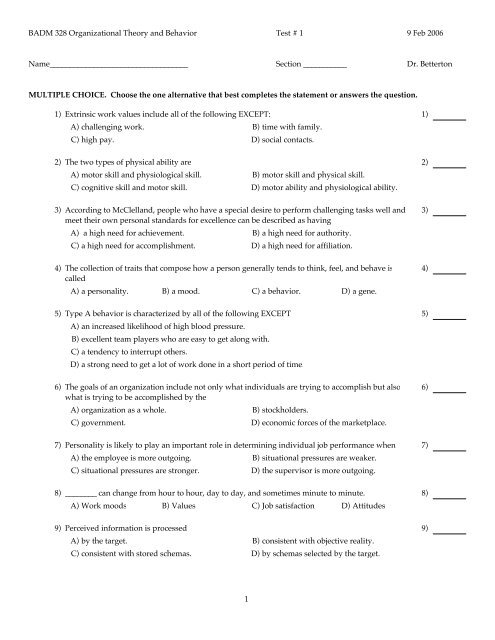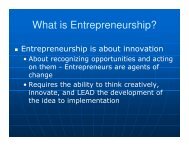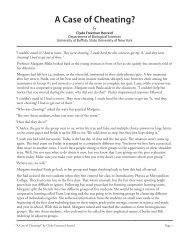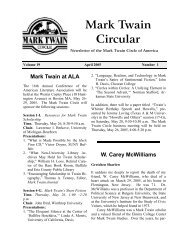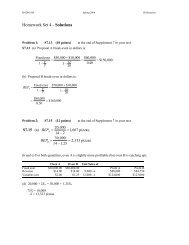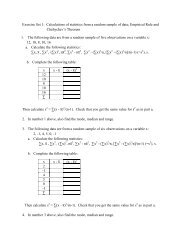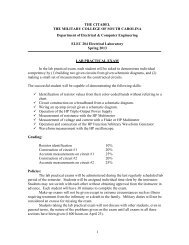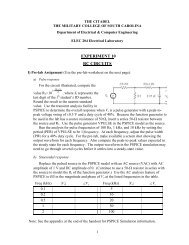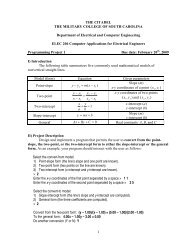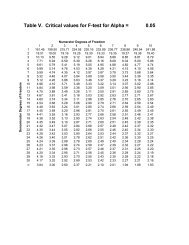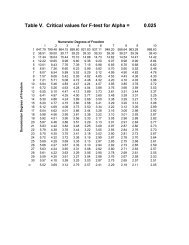Test # 1.tst
Test # 1.tst
Test # 1.tst
Create successful ePaper yourself
Turn your PDF publications into a flip-book with our unique Google optimized e-Paper software.
BADM 328 Organizational Theory and Behavior <strong>Test</strong> # 1 9 Feb 2006<br />
Name___________________________________ Section ___________ Dr. Betterton<br />
MULTIPLE CHOICE. Choose the one alternative that best completes the statement or answers the question.<br />
1) Extrinsic work values include all of the following EXCEPT:<br />
A) challenging work. B) time with family.<br />
C) high pay. D) social contacts.<br />
2) The two types of physical ability are<br />
A) motor skill and physiological skill. B) motor skill and physical skill.<br />
C) cognitive skill and motor skill. D) motor ability and physiological ability.<br />
3) According to McClelland, people who have a special desire to perform challenging tasks well and<br />
meet their own personal standards for excellence can be described as having<br />
A) a high need for achievement. B) a high need for authority.<br />
C) a high need for accomplishment. D) a high need for affiliation.<br />
4) The collection of traits that compose how a person generally tends to think, feel, and behave is<br />
called<br />
A) a personality. B) a mood. C) a behavior. D) a gene.<br />
5) Type A behavior is characterized by all of the following EXCEPT<br />
A) an increased likelihood of high blood pressure.<br />
B) excellent team players who are easy to get along with.<br />
C) a tendency to interrupt others.<br />
D) a strong need to get a lot of work done in a short period of time.<br />
6) The goals of an organization include not only what individuals are trying to accomplish but also<br />
what is trying to be accomplished by the<br />
A) organization as a whole. B) stockholders.<br />
C) government. D) economic forces of the marketplace.<br />
7) Personality is likely to play an important role in determining individual job performance when<br />
A) the employee is more outgoing. B) situational pressures are weaker.<br />
C) situational pressures are stronger. D) the supervisor is more outgoing.<br />
8) ________ can change from hour to hour, day to day, and sometimes minute to minute.<br />
A) Work moods B) Values C) Job satisfaction D) Attitudes<br />
9) Perceived information is processed<br />
A) by the target. B) consistent with objective reality.<br />
C) consistent with stored schemas. D) by schemas selected by the target.<br />
1)<br />
2)<br />
3)<br />
4)<br />
5)<br />
6)<br />
7)<br />
8)<br />
9)<br />
1
BADM 328 Organizational Theory and Behavior <strong>Test</strong> # 1 9 Feb 2006<br />
10) How a worker feels about a job represents the ________ component of the worker's attitude toward<br />
the job.<br />
A) cognitive B) affective C) temperamental D) behavioral<br />
11) ________ is the set of values or beliefs that are approved or sanctioned in that society.<br />
A) Ethics B) Legislation<br />
C) Morality D) National culture<br />
12) As a supervisor, John Layman believes one of his employees excels due to "pure, dumb luck." John<br />
is making<br />
A) an external attribution. B) an internal attribution.<br />
C) a biased decision. D) an attribution error.<br />
13) Individuals likely to experience negative moods at work, feel stressed, and generally have a<br />
negative orientation toward the work situation are said to be<br />
A) introverted. B) high on neuroticism.<br />
C) psychologically disturbed. D) extroverted.<br />
14) Roger Riley is a new department manager at Kelly & Kin Company. Two of his most important<br />
tasks are to encourage his employees to do a good job and to orchestrate different individual and<br />
group behaviors to help ensure all of his employees are working toward his department's goals.<br />
This set of responsibilities is also referred to as<br />
A) planning. B) leading. C) organizing. D) controlling.<br />
15) The managerial function that allows managers to evaluate how well they are performing the other<br />
management functions is<br />
A) planning. B) leading. C) organizing. D) controlling.<br />
16) Social responsibility refers to an organization's moral responsibility toward<br />
A) any person or group outside the organization.<br />
B) people inside and outside the organization.<br />
C) people or groups outside the organization that are directly affected by its actions.<br />
D) its own employees and customers.<br />
17) The three components of perception are<br />
A) comprehension, interpretation, and explanation.<br />
B) observer, observation target, and opinion.<br />
C) sight, hearing, and feel.<br />
D) situation, perceiver, and target of perception.<br />
18) Planning is a complex and difficult task because the decisions managers usually need to make<br />
A) affect many people. B) are time consuming and irreversible.<br />
C) are very expensive. D) are surrounded by uncertainty.<br />
10)<br />
11)<br />
12)<br />
13)<br />
14)<br />
15)<br />
16)<br />
17)<br />
18)<br />
2
BADM 328 Organizational Theory and Behavior <strong>Test</strong> # 1 9 Feb 2006<br />
19) Verbal ability is<br />
A) the ability to understand written materials.<br />
B) the extent to which an individual understands and is able to use written and spoken material.<br />
C) the extent to which an individual can come up with words and sentences quickly.<br />
D) the extent of a person's vocabulary.<br />
20) Individuals who exhibit more of the self-monitoring trait than average are more likely to<br />
A) employ schemas. B) develop and use stereotypes.<br />
C) be neurotic. D) conform to situational norms.<br />
21) When Managers give direct command and orders to subordinates, they are filling which<br />
managerial role?<br />
A) Figurehead B) Liaison C) Leader D) Monitor<br />
22) Experience from research on separated identical twins suggests that approximately ________<br />
percent of the variation in people's personalities can be attributed to genetic factors.<br />
A) 65 B) 50 C) 25 D) 35<br />
23) As defined in the text, organizational behavior is the study of<br />
A) the many factors that impact how organizations respond to individuals and groups and how<br />
organizations respond to their environments.<br />
B) the many factors that affect how individuals and groups respond to and act in organizations<br />
and how organizations manage their environments.<br />
C) how people react at work and how environments respond to organizational actions.<br />
D) the many factors that impact how individuals and groups manage organizations and how<br />
environments respond to organizations.<br />
24) The FACES Scale<br />
A) is used to measure positive and negative affectivity.<br />
B) was developed as part of the Apollo space program to predict employee productivity.<br />
C) is part of the job descriptive index.<br />
D) is designed to measure job satisfaction.<br />
25) Workers who feel excited, enthusiastic, active, strong, and elated are experiencing<br />
A) organizational commitment. B) openness to experience.<br />
C) positive work moods. D) job satisfaction.<br />
26) In a(n) ________, an organization takes in resources from its external environment and converts or<br />
transforms them into goods and services that are sent back to that environment, where they are<br />
bought by customers.<br />
A) closed system B) conversion stage<br />
C) open system D) input stage<br />
19)<br />
20)<br />
21)<br />
22)<br />
23)<br />
24)<br />
25)<br />
26)<br />
3
BADM 328 Organizational Theory and Behavior <strong>Test</strong> # 1 9 Feb 2006<br />
27) A set of behaviors or tasks a person is expected to perform because of the position he or she holds<br />
in a group or organization is referred to as a(n)<br />
A) role. B) skill. C) norm. D) attitude.<br />
28) Managing ability by selection requires that managers identify all of the following EXCEPT<br />
A) accurate measurement of needed abilities.<br />
B) the exact placement of workers into jobs.<br />
C) the tasks they want workers to accomplish.<br />
D) the abilities needed to accomplish necessary tasks.<br />
29) A specific component of personality that describes particular tendencies a person has to feel, think,<br />
and act in a certain way is<br />
A) a mood. B) a behavior. C) a trait. D) an ability.<br />
30) Which of the following is NOT an attributional bias?<br />
A) schema attribution effect B) fundamental attribution error<br />
C) actor-observer effect D) self-serving attributions<br />
31) People's personal convictions about what end states one should expect from work and how one<br />
should behave at work constitute<br />
A) work values. B) work moods. C) work behaviors. D) work attitudes.<br />
32) Individuals who are antagonistic, unsympathetic, and rude are said to be<br />
A) low on extroversion. B) high on introversion.<br />
C) low on agreeableness. D) high on neuroticism.<br />
33) Turnover is a behavior that must be<br />
A) eliminated. B) reduced. C) managed. D) changed.<br />
34) The cognitive component of a worker's attitude is the<br />
A) employee's thoughts about how to behave in his or her job or organization.<br />
B) employee's beliefs about the job or organization.<br />
C) employee's feelings about his or her job or organization.<br />
D) employee's ethical stance.<br />
35) An important step in preventing stereotyping is<br />
A) to eliminate the use of schemas.<br />
B) to think about workers in terms of job performance or similar criteria and not characteristics<br />
such as age or race.<br />
C) to not acknowledge that someone is a different race, age, gender, or nationality.<br />
D) to treat all workers identically and not consider any individual differences when making<br />
decisions.<br />
27)<br />
28)<br />
29)<br />
30)<br />
31)<br />
32)<br />
33)<br />
34)<br />
35)<br />
4
BADM 328 Organizational Theory and Behavior <strong>Test</strong> # 1 9 Feb 2006<br />
36) The level of job satisfaction that a person experiences is affected by all of the following EXCEPT<br />
A) physical characteristics. B) the work situation.<br />
C) personality. D) social influence.<br />
37) The best-accepted trait model of personality focuses on five general traits at the top of the trait<br />
hierarchy, these traits include<br />
A) extroversion, neuroticism, and locus of control.<br />
B) neuroticism, self-esteem, and locus of control.<br />
C) extroversion, self-monitoring, and neuroticism.<br />
D) conscientiousness, agreeableness, and openness to experience.<br />
38) ________ is an advantage for performing jobs that require innovation.<br />
A) Positive affectivity B) Agreeableness<br />
C) Openness to experience D) External locus of control<br />
39) When Herzberg asked workers to describe a time when they felt very positive about their jobs and<br />
a time when they felt particularly bad about their jobs, he was using the data collection method<br />
known as<br />
A) the critical incidents technique. B) extrinsic-intrinsic sampling.<br />
C) the motivator-hygiene method. D) the facets model.<br />
40) The extent to which workers experience different moods at work is determined by<br />
A) the situation. B) their personalities.<br />
C) the situation and their personalities. D) unknown factors.<br />
41) The process by which workers with similar personalities are attracted to and hired by<br />
organizations and those with dissimilar personalities leave is described by the<br />
A) situation-person debate.<br />
B) attraction-selection-augmentation process.<br />
C) good old boy network.<br />
D) attraction-selection-attrition framework.<br />
42) According to the text, a recent review of several studies concluded that the association between job<br />
satisfaction and job performance is<br />
A) decreasing due to the increasing number of baby-busters in the workforce.<br />
B) higher in unionized settings.<br />
C) not meaningful. However I do not buy this because Dr. Betterton told us about a recent study<br />
(meta analysis) that does show a moderate association between job satisfaction and job<br />
performance!<br />
D) stronger for men than for women.<br />
43) The three levels of analysis that are studied in organizational behavior are<br />
A) affective, cognitive, and behavioral. B) individual, organizational, and societal.<br />
C) individual, group, and organizational. D) traits, behaviors, and results.<br />
36)<br />
37)<br />
38)<br />
39)<br />
40)<br />
41)<br />
42)<br />
43)<br />
5
BADM 328 Organizational Theory and Behavior <strong>Test</strong> # 1 9 Feb 2006<br />
44) ________ involves grouping workers into, groups, teams, or departments according to the kinds of<br />
tasks they perform.<br />
A) Designing B) Organizing C) Controlling D) Leading<br />
45) Cognitive and physical ability are determined by<br />
A) influences other than nature or nurture. B) nature alone.<br />
C) nature and nurture. D) nurture alone.<br />
46) Potential benefits of turnover include all of the following EXCEPT<br />
A) provision of advancement opportunities.<br />
B) reduction of the size of the organization.<br />
C) disruption of existing members of an organization.<br />
D) introduction of new ideas into the organization.<br />
47) The need for achievement among top-level executives and managers is<br />
A) less influential in determining their success than is their need for affiliation.<br />
B) less influential in determining their success than is their need for power.<br />
C) more influential in determining their success than is their need for power.<br />
D) more influential in determining their success than is their need for power and affiliation.<br />
48) A schema is dysfunctional if it<br />
A) causes damage to the subject's actual competence.<br />
B) results in inaccurate perceptions.<br />
C) promotes decision making based on prior experience.<br />
D) is based on generalizations.<br />
49) Which of the following is the ability to understand and manage one's own feelings and emotions<br />
and the feelings and emotions of others?<br />
A) Emotional intelligence B) Spacing ability<br />
C) Perceptual ability D) Deductive ability<br />
50) Leading is when managers<br />
A) encourage workers and coordinate individual and group behaviors so that all organizational<br />
members are working toward organizational goals.<br />
B) monitor and evaluate performance at all levels of analysis to achieve organizational goals.<br />
C) establish their organization's strategy to allocate resources to achieve organizational goals.<br />
D) establish an arrangement of relationships that dictates how members work together to achieve<br />
organizational goals.<br />
51) Type A's<br />
A) are more likely to have conflicts with their subordinates and with co-workers than Type B's.<br />
B) prefer long-term situations or projects.<br />
C) are more likely to be effective in situations that require a lot of interaction.<br />
D) have less of a tendency toward hostility.<br />
44)<br />
45)<br />
46)<br />
47)<br />
48)<br />
49)<br />
50)<br />
51)<br />
6
Answer Key<br />
<strong>Test</strong>name: TEST # 1<br />
1) A<br />
2) B<br />
3) A<br />
4) A<br />
5) B<br />
6) A<br />
7) B<br />
8) A<br />
9) C<br />
10) B<br />
11) D<br />
12) A<br />
13) B<br />
14) B<br />
15) D<br />
16) C<br />
17) D<br />
18) D<br />
19) B<br />
20) D<br />
21) C<br />
22) B<br />
23) B<br />
24) D<br />
25) C<br />
26) C<br />
27) A<br />
28) B<br />
29) C<br />
30) A<br />
31) A<br />
32) C<br />
33) C<br />
34) B<br />
35) B<br />
36) A<br />
37) D<br />
38) C<br />
39) A<br />
40) C<br />
41) D<br />
42) C<br />
43) C<br />
44) B<br />
45) C<br />
46) C<br />
47) B<br />
48) B<br />
49) A<br />
50) A<br />
7
Answer Key<br />
<strong>Test</strong>name: TEST # 1<br />
51) A<br />
8


